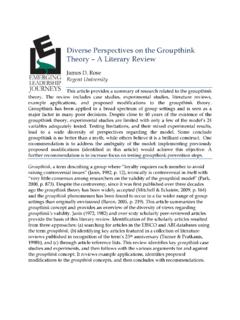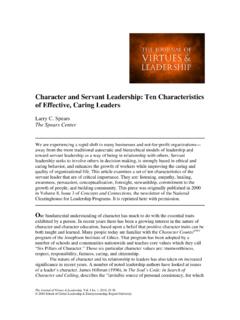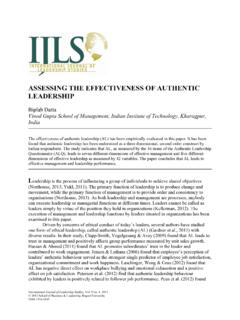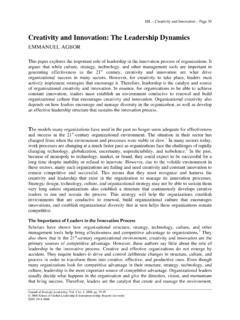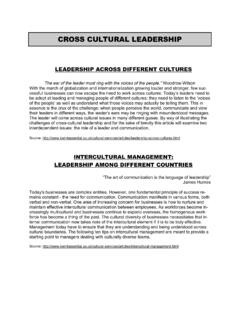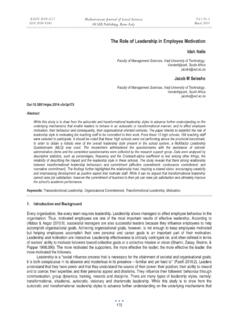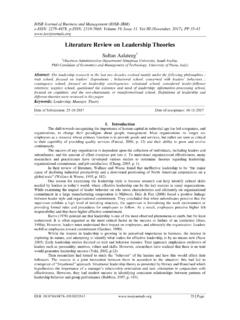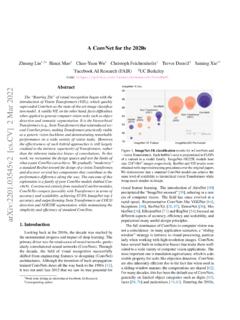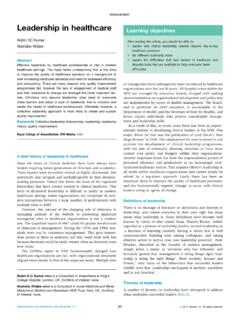Transcription of Transformational versus Servant Leadership: A Difference ...
1 REGENT UNIVERSITY Transformational versus Servant Leadership: A Difference in Leader Focus A Difference in Leader Focus Servant Leadership Research Roundtable August 2003 A. Gregory Stone, Regent University F. Russell, , CMA, CPA Emory & Henry College Patterson, Regent University This article examines Transformational leadership and Servant leadership to determine what similarities and differences exist between the two leadership concepts. The authors posit that the primary Difference between Transformational leadership and Servant leadership is the focus of the leader. The Transformational leader's focus is directed toward the organization, and his or her behavior builds follower commitment toward organizational objectives, while the Servant leader's focus is on the followers, and the achievement of organizational objectives is a subordinate outcome.
2 The extent to which the leader is able to shift the primary focus of leadership from the organization to the follower is the distinguishing factor in classifying leaders as either Transformational or Servant leaders. This article also looks at the next stage of developmental issues in Servant leadership, such as the challenges facing empirical investigation and measurement, and the changes that are occurring in current thinking about the Servant leadership approach. Ultimately, the case is made that although different, both Transformational leadership and Servant leadership offer the conceptual framework for dynamic leadership. Transformational leadership, initiated by James MacGregor Burns (1978) and Bernard M.
3 Bass (1985a), has become a very popular concept in recent years. Both researchers and practitioners have gravitated to the theory and have employed it in a variety of organizational settings. Similarly, the concept of Servant leadership, which Robert Greenleaf (1977) formulated in the modern era, has received substantial attention in the contemporary leadership field. A cursory glimpse of Transformational leadership and Servant leadership leaves 2 Transformation versus Servant Leadership - Stone the perception that the concepts are rather similar. In fact, some individuals question whether there is any real Difference between the concepts. This article first examines the theoretical framework, characteristics, and focus of both Transformational leadership and Servant leadership to determine what similarities and differences exist between the two leadership concepts.
4 Thereafter, the article differentiates the concepts along the dimension of leader focus. The primary premise of the article is that Transformational leaders tend to focus more on organizational objectives while Servant leaders focus more on the people who are their followers. This tendency of the Servant leader to focus on followers appears to be the primary factor that distinguishes Servant leadership from Transformational leadership. Otherwise, there are many similarities between the two leadership concepts. A clear understanding of both frameworks helps to understand the many similarities and the aforementioned distinction. Transformational Leadership Bass and Avolio (Bass, 1985a; Bass & Avolio, 1990) developed Burns (1978) ideas and posited the formal concept of Transformational leadership.
5 Their work built not only upon the contribution of Burns but also those made by Bennis and Nanus (1985), Tichy and Devanna (1986), and others. Bass (1990b) specified that Transformational leadership "occurs when leaders broaden and elevate the interests of their employees, when they generate awareness and acceptance of the purposes and mission of the group, and when they stir their employees to look beyond their own self-interest for the good of the group" (p. 21). Bass (1990a) stipulates that this transcending beyond self-interest is for the "group, organization, or society" (p. 53). In essence, Transformational leadership is a process of building commitment to organizational objectives and then empowering followers to accomplish those objectives (Yukl, 1998).
6 The result, at least in theory, is enhanced follower performance (Burns, 1998; Yukl, 1998). Burns (1978) considered leaders to be either Transformational or transactional, while others view leadership as a continuum with transactional leadership at one end and Transformational leadership at the other. Bass (1990a) said that transactional leadership occurs when leaders exchange promises of rewards and benefits to subordinates for the subordinates fulfillment of agreements with the leader (p. 53). The transactional leader, according to Daft (2002), recognizes followers needs and then defines the exchange process for meeting those needs. Both the leader and the follower benefit from the exchange transaction.
7 Transactional leadership is based on bureaucratic authority, focuses on task completion, and relies on rewards and punishments (Tracey & Hinkin, 1998). Transformational leadership differs substantially from transactional leadership. It is concerned more about progress and development. Furthermore, Transformational leadership enhances the effects of transactional leadership on followers (Bass, 1985b, 1990a). Transformational leaders transform the personal values of followers to support the vision and goals of the organization by fostering an environment where relationships can be formed and by establishing a climate of trust in which visions can be shared (Bass, 1985a). Avolio, Waldman, and Yammarino (1991) established four primary behaviors that constitute Transformational leadership: 1) idealized influence (or charismatic influence), 2) inspirational motivation, 3) intellectual stimulation, and 4) individualized consideration.
8 The following discussion summarizes these areas and identifies the characteristics that accompany each of them. Servant Leadership Research Roundtable August 2003 3 Idealized influence. Idealized influence is the charismatic element of Transformational leadership in which leaders become role models who are admired, respected, and emulated by followers (Avolio & Bass, 2002; Bass, 1998; Bass & Avolio, 1994). Consequently, followers demonstrate a high degree of trust in such leaders (Bass, 1990b; Jung & Avolio, 2000). Idealized influence in leadership also involves integrity in the form of ethical and moral conduct (Tracey & Hinkin, 1998). The development of a shared vision is an integral component of the idealized, Transformational leader's role (Jung & Avolio, 2000).
9 It helps others to look at the futuristic state, while inspiring acceptance through the alignment of personal values and interests to the collective interests of the group's purposes (Avolio & Bass, 2002; Bass, 1990b, 1998; Jung & Avolio). Transformational leaders are also willing to take and share risks with followers (Avolio & Bass, 2002; Bass, 1998). Inspirational motivation. Transformational leaders inspire and motivate others by "providing meaning and challenge to their followers' work" (Avolio & Bass, 2002, p. 2). The spirit of the team is "aroused" while "enthusiasm and optimism are displayed" (Bass, 1998, p. 5). The Transformational leader builds relationships with followers through interactive communication, which forms a cultural bond between the two participants and leads to a shifting of values by both parties toward common ground.
10 The leader inspires followers to see the attractive future state, while communicating expectations and demonstrating a commitment to goals and a shared vision . Idealized influence and inspirational motivation are usually combined to form charismatic-inspirational leadership (Bass, 1998). Intellectual stimulation. Transformational leaders stimulate their followers' efforts "to be innovative and creative by questioning assumptions, reframing problems, and approaching old situations in new ways" (Avolio & Bass, 2002, p. 2). Followers mistakes are not publicly criticized and creativity is openly encouraged. Transformational leaders solicit their followers' ideas and creative solutions to problems, thereby including followers in problem solving.

